Contact Us
- Support
- VTube Technical Articles
- VTube-LASER
- VTube-LASER Tangent Point Envelope Tolerances
VTube-LASER Tangent Point Envelope Tolerances
Qualifying tube shapes with tangent point envelopes has been a tube fabrication standard for decades.
The Tangent point grid is the equivalent of a GD&T SURFACE PROFILE TOLERANCE. Newer versions of VTube-LASER have started using SURFACE PROFILE in the Tangent grid in order to align the meaning with standard GD&T terminology.
The values for this qualification method are half of a GD&T DIAMETER POSITION TOLERANCE.
Why are Tangent Points Important in Qualifying Tube Shapes?
Centerline tangent point deviations are important because they represent the best set of points along the centerline to qualify the shape of a tube.
Centerline tangent points are important points used to qualify tube shapes when they are compared to a master part shapes. This page describes why they are important for qualifying tube shapes, and how to properly read the tangent deviation reports and charts in VTube-LASER.
In tube fabrication, a tangent point is a centerline point where a straight meets a bend. These are considered the best datum points for qualifying a tube shape because they are the reduced set of points that best represent the position of a cylinder in space.
The tangent point deviations are even directly applicable to a GD&T profile tolerance of the tube wall. VTube-LASER tolerance envelopes are spherical radius true positions from the centerline tangent points. GD&T profile tolerances are tolerances for an entire diameter true position (rather than the radius of diameter).
Applying GD&T profile tolerances to VTube-LASER is easy: Always cut the GD&T profile tolerances in half to get the equivalent tolerance in VTube-LASER. For example, a GD&T profile tolerance of 3 mm is identical to a VTube-LASER tolerance envelope of 1.5 mm. | 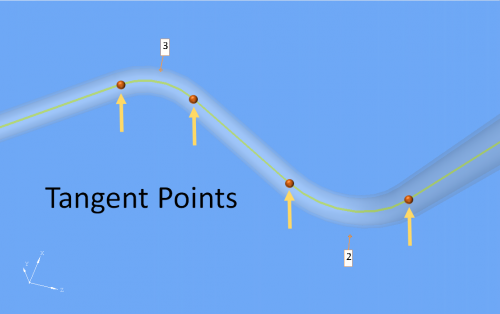
|
COMPARE XYZ Tangent Point Deviations to XYZ Intersection Point Deviations
Centerline XYZ intersection points (not the same as centerline XYZ tangent points) are sometimes used for tube shape qualification. However, intersection points are not a good choice for tube-shape qualification because: - Intersection deviations tend to exaggerate the deviations mathematically. The exaggeration grows was the bend angle approaches either 0 degrees or 180 degrees. In both situation the deviation exaggeration grows as the intersection centerlines approach being parallel.
- Bend angles that approach 180-degrees create the worst exaggeration because intersection point deviation grows as the intersection point leaves the tube space.
This is the nature of polar geometry. One degree of change at 10 mm is 0.17 mm. One degree of change at 1000 mm is 17.45 mm. Tangent points don't have this problem, because they are always closely connected to the straight sections of the tube shape.
| 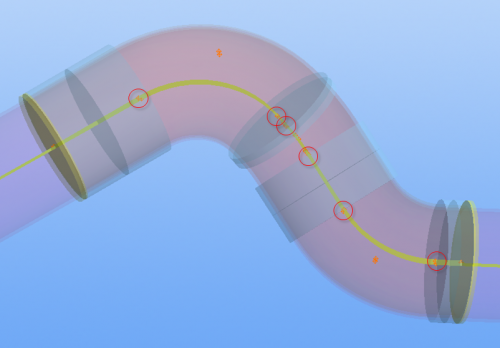
|
A Visual Example of the Problem With Using Intersection Points for Qualification
See these two images to help understand the problem with using intersection points for qualification.
The white tube is the MASTER part. The pink tube is the MEASURED ALIGNED part. The blue envelopes are the tolerance envelopes for this tube qualification.
The two tangents show 0.054 and 0.046 inches in deviation. It's easy to see that the pink straights are well inside the blue envelopes. This part qualifies according to the tangent point deviations. | 
|
However, the intersection points are separated by 0.332 inches.
The intersection deviation is 6 times larger than the profile deviation of the tube. Intersection deviations do not act as a good representative of the actual profile deviation. It is possible to over qualify a part using them.
See VTube Intersection Point Tolerances for more information about intersection deviations. | 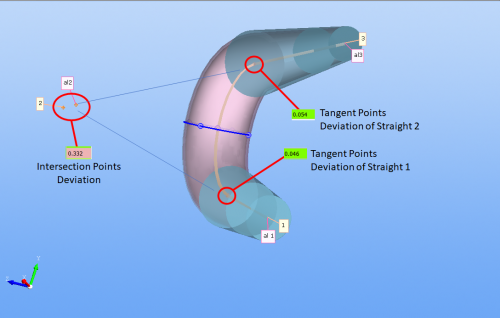
|
Tangent Point Deviations in the Inspection Data Grid
The Tangent chart is represented by a grid of straights for each row with tangent points and midpoints for each straight: - T1 = Tangent 1 Deviation
- MP = Midpoint Deviation
- T2 = Tangent 2 Deviation
- T1t = Tangent 1 Deviation Tolerance
- MPt = Midpoint Deviation Tolerance
- T2t = Tangent 2 Deviation Tolerance
Note that the two end points are also included in the tangent charts are reports (T1d in straight 1, and T2d in the last straight). They are an exception to the technical tangent definition given above because there is no bend attached to these points. But these points still have value in determining if the part is the correct shape, so it is convenient to include them in this chart and grid - even though they are not really tangents. Midpoint deviations are always less than the highest corresponding tangent deviation, and higher than the lowest corresponding tangent deviation. They are included in traditional reports so that you can have three separate deviation tolerances in a straight. (T1-MP-T2) | 
|
The Same Data In Reports
The same tangent data can be shown in the reports like this.
Some customers prefer to modify the report to show only their critical data. For example, they may remove the midpoints or the end angles from the reports(which can be done by changing the report templates).
(For those with active VTube Software Maintenance Plans: We will help you modify the report templates if requested.) | 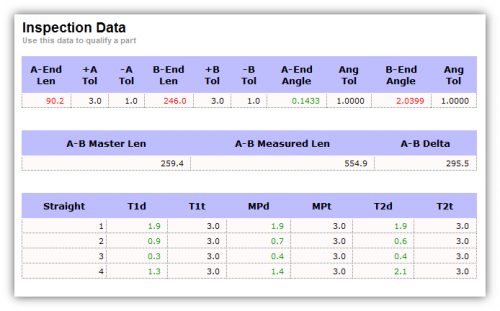
|
How to Understand the Tangent Data
The image on the right shows the visual representation of the chart and report above. The deviations in the grid match the part in the image. The part is made transparent so that you can see the two centerlines inside the tube. (It's easy to make parts transparent by setting the transparency value about 0.75 inside the Parametric Tube control menu under Models.) In the image below shows how the distance T1d is measured in the second straight:
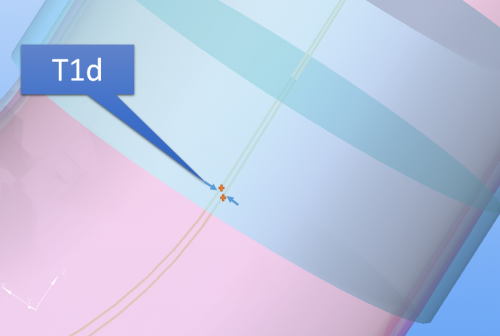
In this case, the T1d value is 0.9mm for straight 2.
| 
|
About End Point Deviations
Automatic Internal Trimming of End Points for Shape
Even though the end points are not tangents, we can still use them in the chart because they qualify the part the same way that tangent points do.
A key in understanding the T1d of straight one and the T2d of the last straight is to remember that the deviation is not the same as how long or short the straights are relative to the master tube shape. See the illustration on the right to understand why.
The MASTER to MEASURED end point deviation in the Tangent grid is 1.9mm. The measurement is the distance between the two lines at the corresponding end points - as if the MEASURED WERE TRIMMED.
(The Measured part is the pink part. The Master part is white.) | 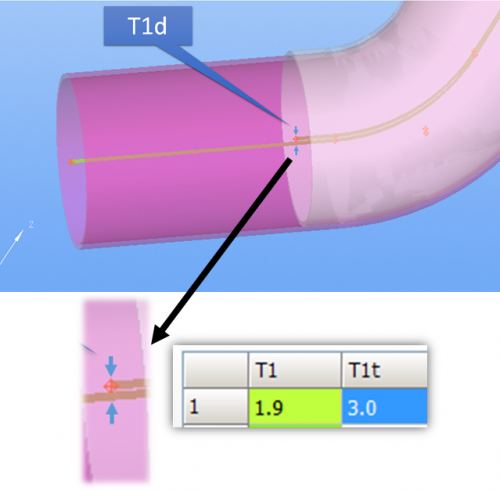
|
Untrimmed End Points for Lengths
However, the end length is 90.2mm too long. In this application, the customer bent the part 90mm too long on purpose in order to give the bend arm clamp die enough material on the first straight to grip. Notice that, even though the part is significantly too long, the BEST FIT algorithm didn't use the actual measured end point in the alignment. The alignment was based on the trimmed point on the measured centerline that was nearest the master end point. So, in this case the part shape in space is qualified - but it needs trimming by 90.2mm to also qualify the end length (another critical qualifier). | 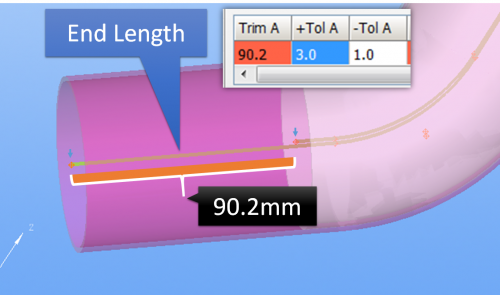
|
Typical Industry Tangent Point Envelope Tolerances
In working with thousands of customers over the past few decades, we've seen some trends in accepted envelope deviation tolerances.
Please remember that GD&T tube profile tolerances are always double the VTube-LASER envelope tolerances. So, a GD&T profile tolerance of 3 mm is VTube-LASER's 1.5 mm envelope tolerance. All tolerances that we show below are half the GD&T profile tolerances. Here are what we commonly see: Aerospace and Automotive Fluid LinesDiameter Range | Envelope Tolerance | 12.7 mm (0.5 inch) diameter tubes or less | 1 mm (0.039 inches) | Greater than 12.7 mm (0.5 inch) | 2 mm (0.078 inches) |
Automotive Exhaust PipesDiameter Range | Envelope Tolerance | 50 mm to 76 mm | From 2 mm to 3 mm | 76 mm to 102 mm | 3 mm | Larger than 102 mm | 3 mm or greater |
Automotive Fluid LinesLength Range | Envelope Tolerance | Up to 1000mm long after bending | From 1 mm to 2 mm | Over 1000mm long after bending | 3 mm or greater |
ShipbuildingDiameter Range | Envelope Tolerance | All Diameters | 6 mm |
HVACDiameter Range | Envelope Tolerance | All Diameters | 2 to 3 mm |
Structural Tubes (Frames)Diameter Range | Envelope Tolerance | All Diameters | 2 to 3 mm |
|
GD&T and VTube-LASER Tolerance Envelopes










